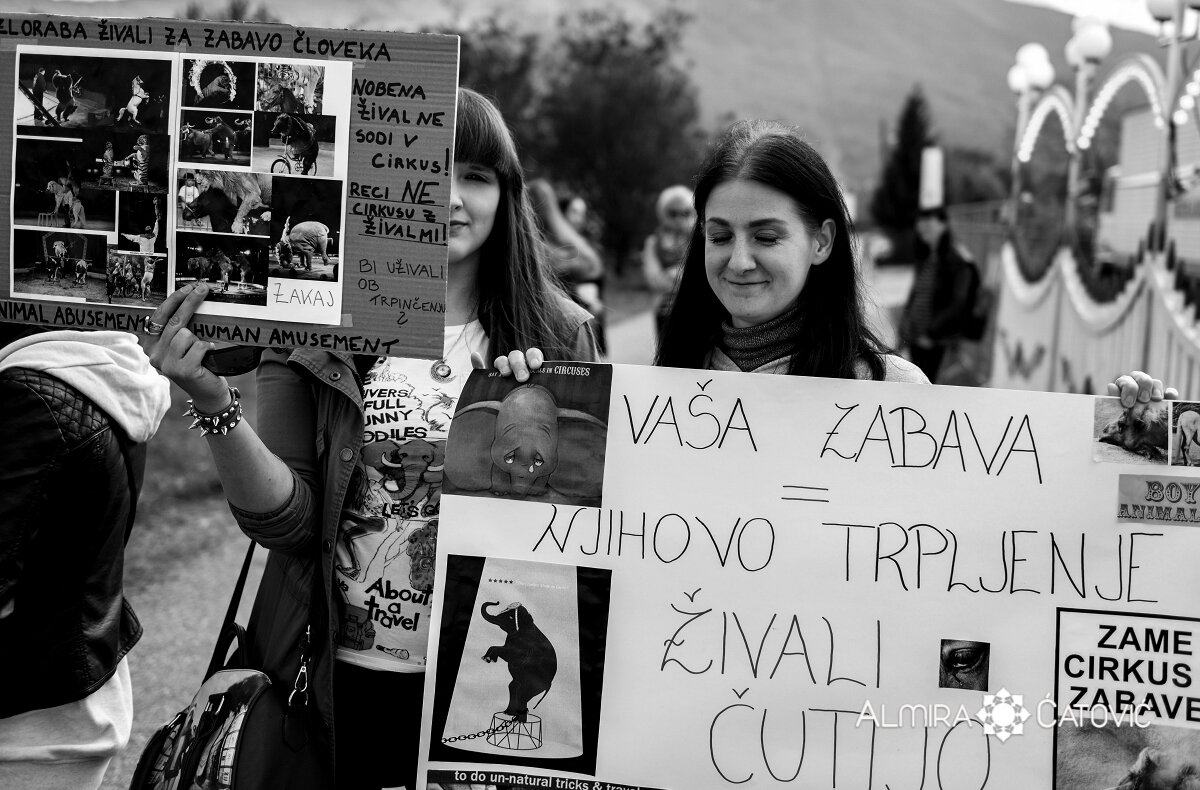

















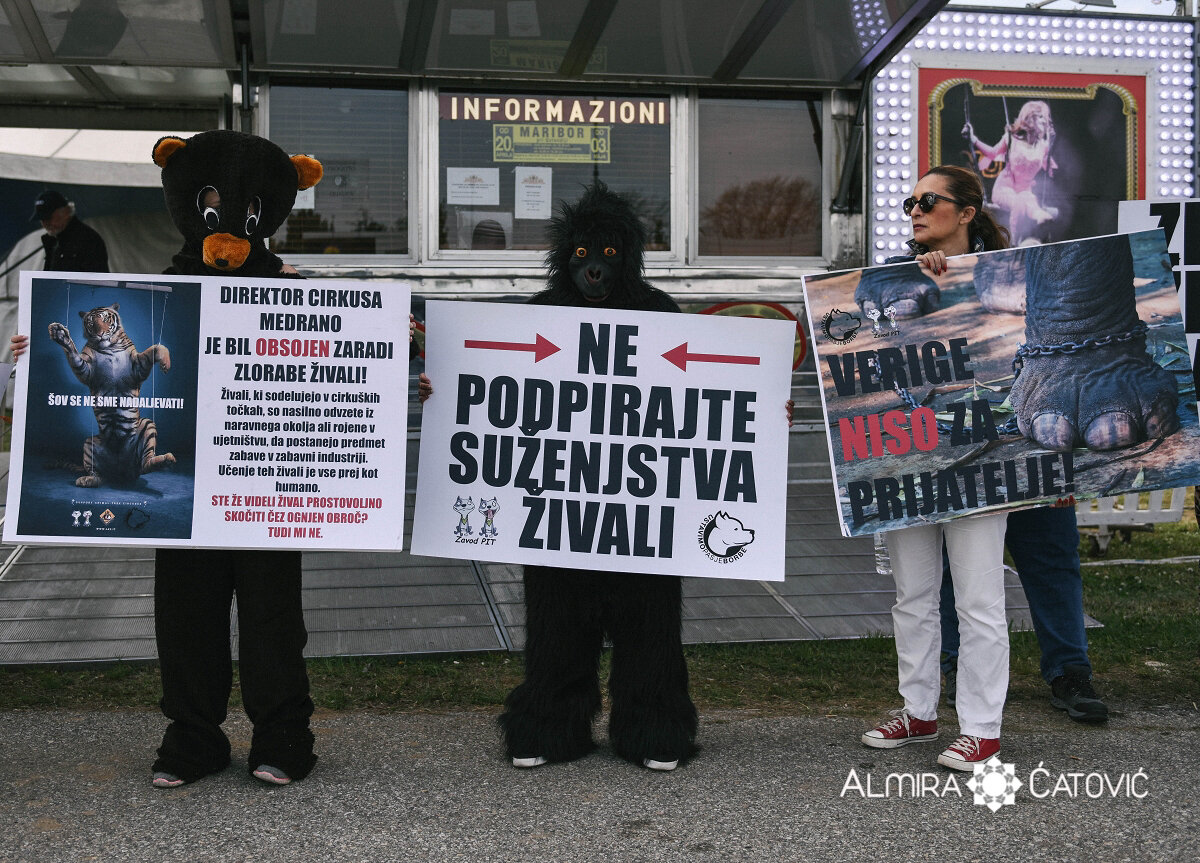










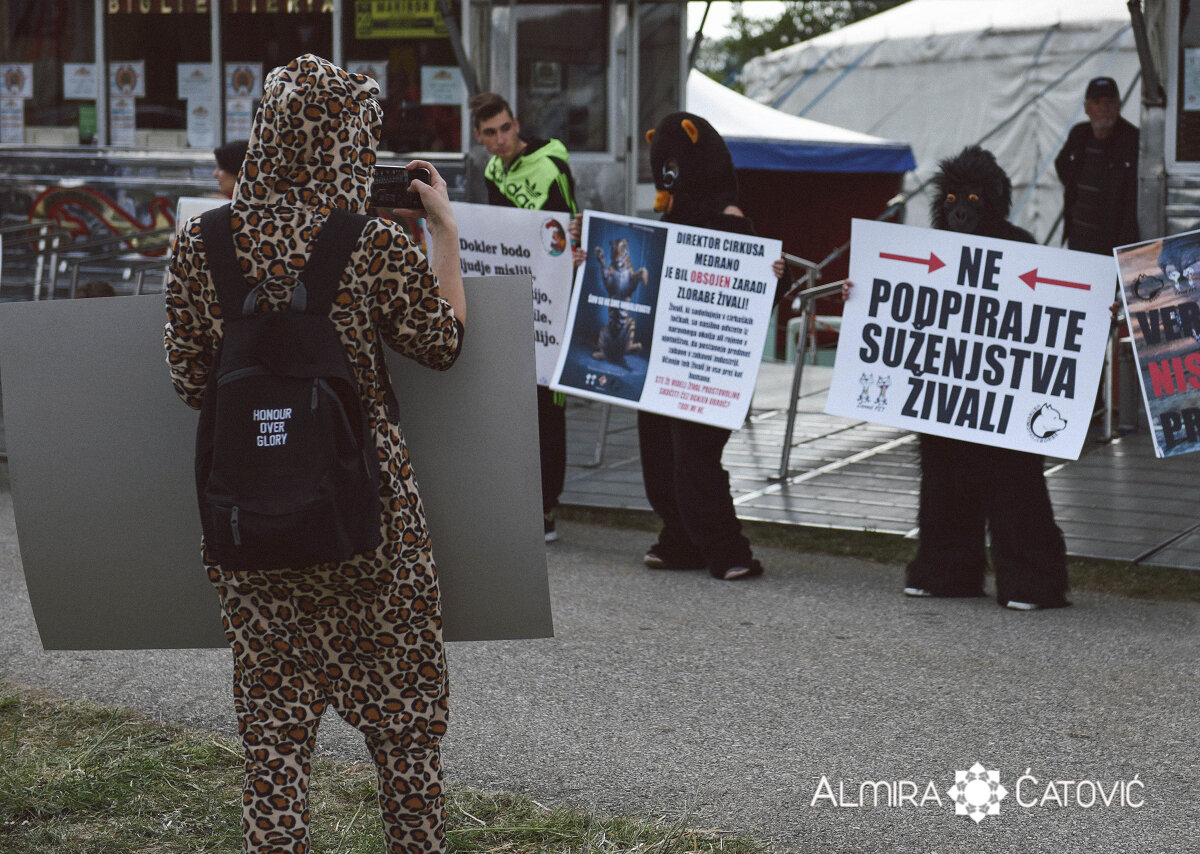











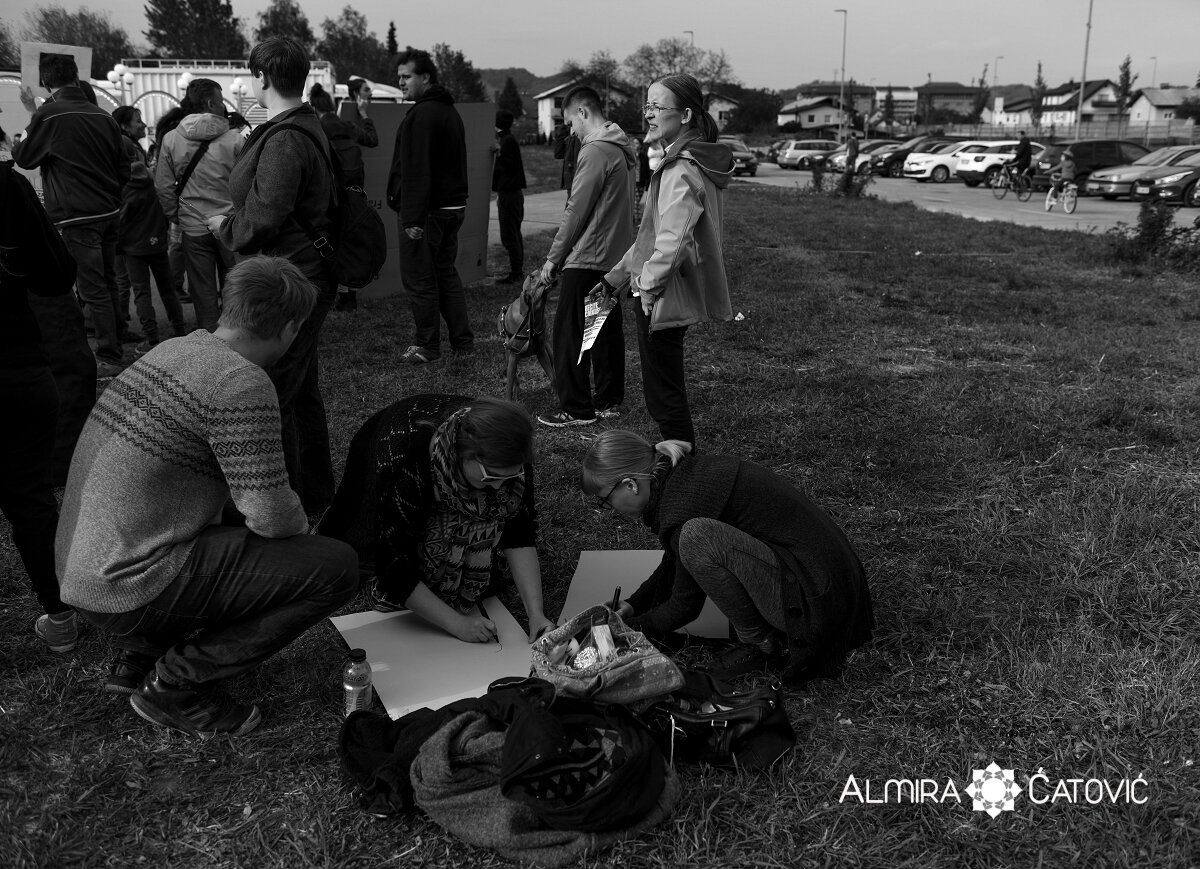







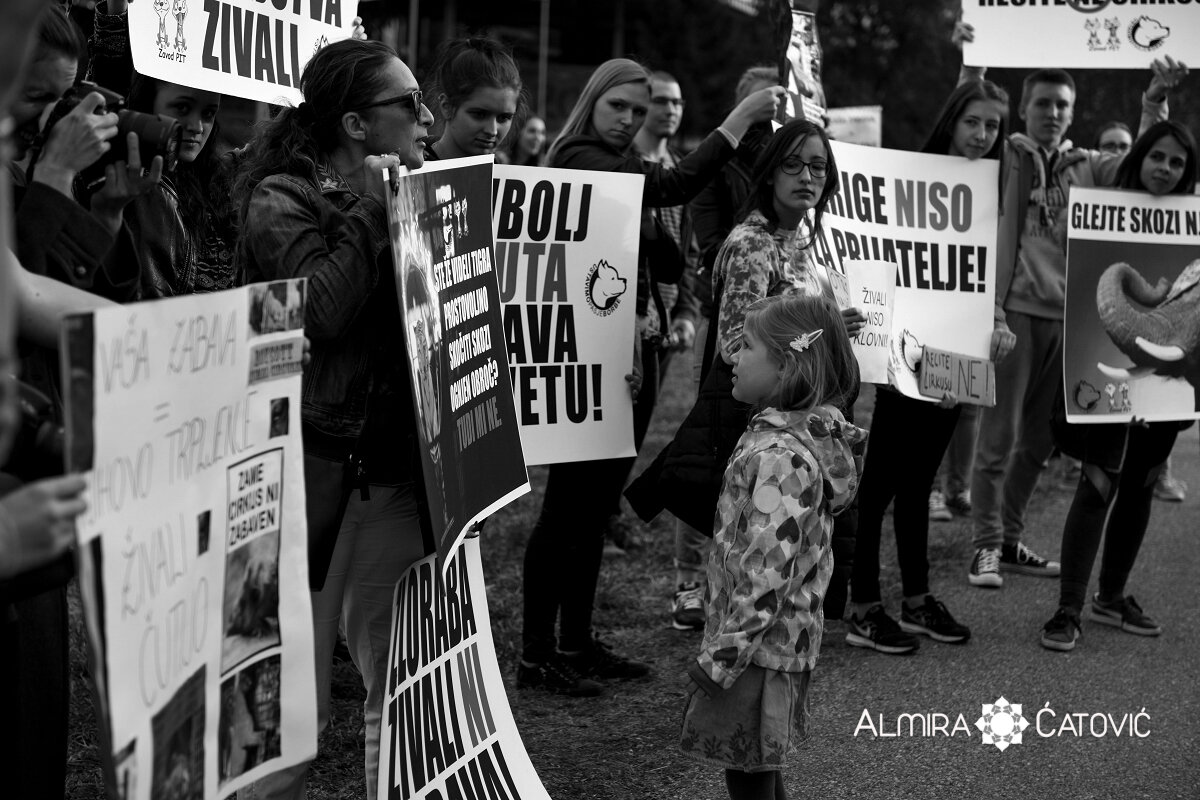









English
Circus and what the fuss is all about
Italian circus Medrano is considered one of Europe’s oldest circuses and in its repertoire offers domestic and exotic animals in their shows. And because of exotic animals, precisely said, torcher of them, director of circus Medrano was convicted in Padova (Italy) for animal abuse and cruelty. And though the circus came in Slovenian without exotic animals (it’s forbidden by law to have wild animals in a circus), they came in the company with about 20 dogs and 40 horses and traveled from different cities in Slovenia. Despite the fact that on paper everything is legal and formal and they do not violate any laws, but there is still a question of ethics and why do we buy a ticket to see the show when we know animals are being tortured, no matter whether it is domestic or exotic.
In Ancient Rome fighting with exotic dangerous animals was fun to the delight of crowds and from there the name circus came, that in latin means circle and represents the place where fighting occurred. The circus as we know it today boomed in the 18th century. The modern circus was actually created in England by Philip Astley (1742-1814), a former cavalry Sergeant-Major turned showman. He displayed a remarkable talent as a horse-breaker and trainer. Upon his discharge, Astley chose to imitate the trick-riders who performed, with increasing success, all over Europe. In 1768, Astley settled in London and opened a riding school near Westminster Bridge, where he taught in the morning and performed his “feats of horsemanship” in the afternoon. In London at this time, modern commercial theater (a word that encompassed all sorts of performing arts) was in the process of developing. Astley’s building featured a circular arena that he called the circle or circus, and which would later be known as the ring. Astley’s original ring was about sixty-two feet in diameter. Its size was eventually settled at a diameter of forty-two feet, which has since become the international standard for all circus rings. What were the methods of training with the animals at that time is not exactly known, but what kind of animal treatment is in circus today is well-known thanks so ADI – Animal Defenders International.
When they exposed secretly recordings about the treatment of animals in the circus big changes started. In 2009, Bolivia was the first country that banned circuses, no matter whether they have domestic or wild animals. The first European country which has adopted the same measure was Greece, in 2012, followed by Bosnia and Herzegovina, and Cyprus and Malta, while the majority of other countries, including Slovenia, banned appearance of wild animals in the circus.
When someone is in charged of animal cruelty of wild animals is hard to imagine that that person, organization is any better to consider treating domestic animals. And that was almost impossible to tell to people who come to buy tickets to see Saturday show and to take their kids to the circus. In responding to the protesters where some bizarre statements like this »Well we have three dogs at home and we train them, so what’s the difference?« or »What about the dogs that are trained in dog school,« and the statement that makes me laugh »Do you eat the meat?« Apparently, if you eat meat, you do not have the right to protest against the circus or you can protest only if you are on prana and you take the last bite of food seven years ago. I understand that some people really do not know the background of torture and animal cruelty in the circus and they are bringing children because they want to offer them something special and to children circus is magical place where imagination become alive, and so, I was impressed with those parents who reconsider and changed their mind and actually did not buy the tickets after they realised what is going on behind the show and how animals are being exploited and abused for profit. And with more decisions and actions like this, the less there will be in interest to have a circus with animals and more circuses of »modern era« will arise, where the spirit of the magical world is captured in shows where animals are not involved.
Slovenian
Ko so na dan prišli skrivni posnetki organizacije ADI – Animal Defenders International, kjer so razkrili zlorabo živali v cirkusih, je leta 2009 Bolivija prepovedala cirkuse, ne glede ali gre za udomačene živali ali divje živali in tako postala prva država na svetu, ki je prepovedala tovrstno ”zabavo”. Prva evropska država, ki je sprejela ta ukrep je bila Grčija, in sicer leta 2012, sledile so ji Bosna in Hercegovina, pa Ciper in Malta, medtem ko ima večina ostalih držav, vključno s Slovenijo, prepoved nastopa divjih živali.
In če je nekdo obtožen za maltretiranje divjih živali, potem takem je majhna verjetnost, da je posebej ljubeč in nežen, kadar gre za dresiranje udomačenih živali. In to je bilo skoraj nemogoče dopovedati tistim, ki so v soboto prišli po karte, da bi peljali svoje otroke v cirkus. Tako so s strani obiskujočih letele razne bizarne izjave, kot »Saj sami imamo doma tri pse in jih dresiramo, torej kakšna je razlika?«, ali pa »Kaj pa psi, ki se jih dresira pri nas!« in izjava, ki me je nasmejala »A meso pa ješ?« Torej, če ješ meso, nimaš kaj iskati na teh protestih oziroma protestiraš lahko le, če si na prani in si zaužil zadnji zalogaj hrane pred več kot sedmimi leti! Razumem, da marsikdo res ne ve ozadja mučenja in izživljanja nad živalmi, ki v cirkusu skakljajo pred nami in nam odprejo polje domišljije in magičnosti, kakor otroci doživljajo cirkus. In četudi marsikateri starš ne ve, kako grozoviti so pogoji, v katerih bivajo te živali, ki se jih izkorišča in zlorablja za osebni profit in so otrokom želeli ponuditi nekaj lepega, so si nekateri starši premislili in opustili nakup vstopnice. In več bo takšnih dejanj in manj zanimanja za cirkuse z živalmi, bolj se bodo širili cirkusi »moderne dobe«, ki vseeno ohranjajo magičen svet cirkusa in v svojih šovih ne vključujejo živali.
Italijanski cirkus Medrano velja za enega najstarejših evropskih cirkusov in v svojem repertoarju ponuja zraven domačih živalih nastop tudi eksotičnih; in ravno zaradi slednjih je direktorju tega cirkusa v Padovi bila izrečena zaporna kazen, saj je povzročal fizično in psihično trpljenje. In čeprav eksotičnih živali v Mariboru ni, saj ima Slovenija prepoved divjih živali za zabavo, je cirkus sprva iz Postojne, nato Celja prišel v Maribor v družbi s približno 20 psički in 40 konji, kjer nadaljuje svojo pot v Mursko Soboto in Slovenj Gradec. Kljub temu, da na papirju zadeva deluje pravno formalno urejena in ne kršijo nobenih zakonov, ostaja vprašane etike. Saj s tem, ko kupimo vstopnico, podpremo mučenje in izživljanje nad živalmi, ne glede ali gre za domače ali eksotične.
Eksotične živali oz boji z njmi, so bili ena od zabav v starem Rimu, od koder prihaja ime za cirkus, kjer sama beseda v latinščini pomeni krog in predstavlja prostor, kjer so se odvijale med drugim tudi gladiatorske borbe in ostale vrste zabave željnih Rimljanov. Cirkus, kot ga poznamo danes, se je razmahnil v 18. stoletju, za očeta cirkusa pa velja Anglež Philip Astley (1742-1814), ki je bil po poklicu dresurni jahač ter združil dresurne spretnosti z akrobacijami, žonglerji in klovni. Kljub temu da je veljal za vrhunskega akrobata in čeprav so mnogi triki, ki so bili uporabljeni v njegovih predstavah bili izumljeni že prej, je njegov izum cirkuška arena, ki je sprva imela 19 metrov nato pa bila zožena na 13 metrov premera. Kakšni so bili načini dresiranja živali in kakšen so takrat imeli odnos do živali ni ravno znano veliko, je pa danes toliko bolj vidno, kaj se s temi živalmi počne.




















































